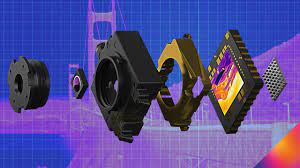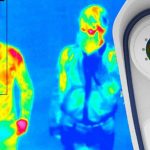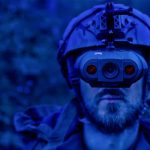Thermal imagers are devices that convert thermal radiation into electrical signals. They are used in a variety of applications, including security, medical diagnosis, industrial inspection, and scientific research.
Thermal imagers work by detecting the infrared radiation emitted by objects. Infrared radiation is invisible to the human eye, but it can be detected by special sensors called detectors. Detector types include bolometers, pyroelectric sensors, and thermocouples.
Bolometers are the most common type of detector used in thermal imaging cameras. Bolometers measure the change in resistance of a material when exposed to infrared radiation. The resistance change is converted into an electrical signal that is then amplified and converted into an image.
Pyroelectric sensors are another common type of detector used in thermal imagers. Pyroelectric sensors are made of materials that generate an electric charge when exposed to infrared radiation. The charge is then converted into an electrical signal and amplified to create an image.
Thermocouples are the third type of detector used in thermal imaging cameras. Thermocouples measure the difference in temperature between two conductors when exposed to infrared radiation. The temperature difference is converted into an electrical signal and amplified to create an image.
Thermal imagers can be used for a variety of applications, including security, medical diagnosis, industrial inspection, and scientific research.
Security: Thermal imaging cameras can be used for security purposes, such as detecting intruders in a dark area or seeing through smoke or fog.
Medical diagnosis: Thermal imaging can be used to detect abnormalities in the human body, such as tumors.
Industrial inspection: Thermal imagers can be used to inspect industrial equipment for hot spots or leaks.
Scientific research: Thermal imagers can be used to study the Earth’s atmosphere and climate.
The different types of thermal imagers
There are two main types of thermal imagers: uncooled and cooled. Uncooled thermal imagers use sensors that are sensitive to infrared radiation. Cooled thermal imagers use sensors that are cooled to very low temperatures, typically below -50°C.
Uncooled thermal imagers are the most common type of thermal imager. They are less expensive than cooled thermal imagers and can be used for a variety of applications.
Cooled thermal imagers are more expensive than uncooled thermal imagers, but they offer several advantages. Cooled thermal imagers have higher resolution and sensitivity than uncooled thermal imagers. They can also operate in a wider range of temperatures, making them ideal for use in extreme conditions.
How to use a thermal imager
To use a thermal imager, you will need to purchase a camera and software. The software is used to control the camera and process the images.
Once you have the camera and software, you will need to calibrate the camera. This is done by setting the temperature range of the objects you want to measure. The calibration process can be different for each application.
After the camera is calibrated, you can begin taking pictures or videos. Thermal imagers typically have a display that shows the infrared image. The images can be saved to a computer for later analysis.
The benefits of using a thermal imager
There are many benefits to using a thermal imager. Thermal imagers can be used for a variety of applications, including security, medical diagnosis, industrial inspection, and scientific research.
Thermal imagers offer several advantages over other types of imaging systems. Thermal imagers can see in the dark and through smoke and fog. They can also measure the temperature of an object without touching it.
Thermal imagers are also less expensive than other types of imaging systems, such as X-ray machines.
The disadvantages of using a thermal imager
There are some disadvantages to using a thermal imager. Thermal imagers can be difficult to use and require special training. They also require a power source and can be large and heavy.



